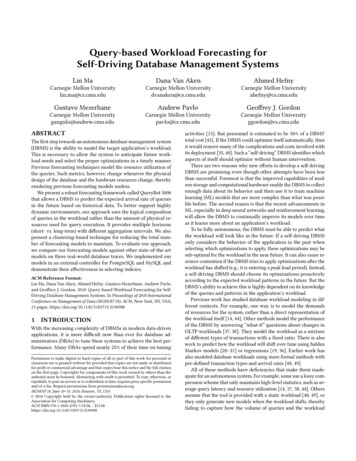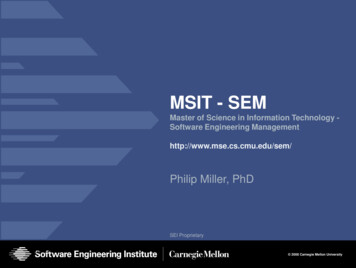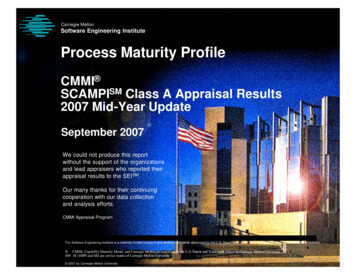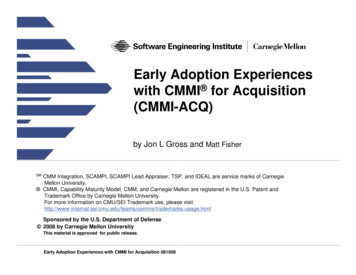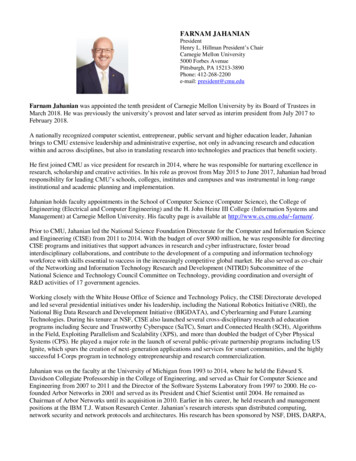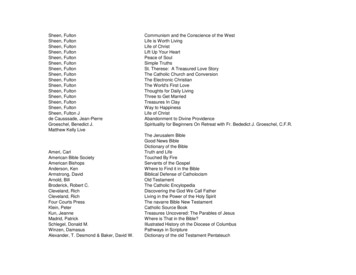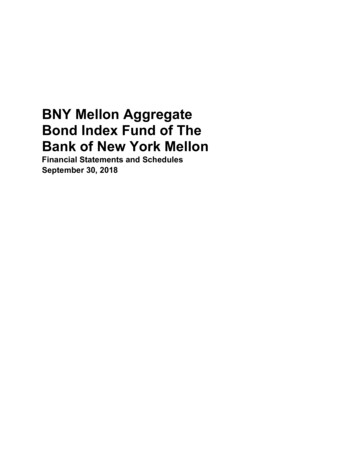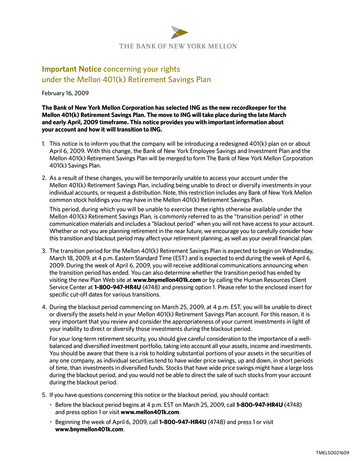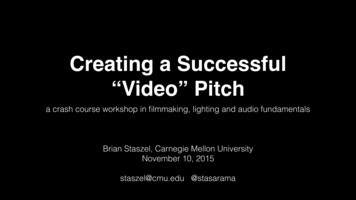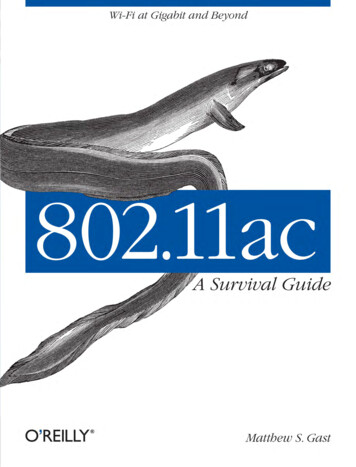
Transcription
802.11ac: A Survival GuideMatthew S. Gast
802.11ac: A Survival Guideby Matthew S. GastCopyright 2013 Matthew S. Gast. All rights reserved.Printed in the United States of America.Published by O’Reilly Media, Inc., 1005 Gravenstein Highway North, Sebastopol, CA 95472.O’Reilly books may be purchased for educational, business, or sales promotional use. Online editions arealso available for most titles (http://safaribooksonline.com). For more information, contact our corporate/institutional sales department: 800-998-9938 or corporate@oreilly.com.Editors: Mike Loukides and Meghan BlanchetteProduction Editor: Kristen BorgProofreader: Rachel HeadAugust 2013:Cover Designer: Karen MontgomeryInterior Designer: David FutatoIllustrators: Robert Romano and Rebecca DemarestFirst EditionRevision History for the First Edition:2013-07-22:First release2015-07-17:Second releaseSee http://oreilly.com/catalog/errata.csp?isbn 9781449343149 for release details.Nutshell Handbook, the Nutshell Handbook logo, and the O’Reilly logo are registered trademarks of O’ReillyMedia, Inc. 802.11ac: A Survival Guide, the image of a common European eel, and related trade dress aretrademarks of O’Reilly Media, Inc.Many of the designations used by manufacturers and sellers to distinguish their products are claimed astrademarks. Where those designations appear in this book, and O’Reilly Media, Inc., was aware of a trade‐mark claim, the designations have been printed in caps or initial caps.While every precaution has been taken in the preparation of this book, the publisher and author assume noresponsibility for errors or omissions, or for damages resulting from the use of the information containedherein.ISBN: 978-1-449-34314-9[LSI]
For L.,who reminds me it’s okay to have my head in the clouds sometimes.And for the NCSA instruction team who made me into a pilot so I can get there:Mike, Terence, Larry, Mike, John, Buzz, and John.
Table of ContentsForeword. . . . . . . . . . . . . . . . . . . . . . . . . . . . . . . . . . . . . . . . . . . . . . . . . . . . . . . . . . . . . . . . . . . . . viiPreface. . . . . . . . . . . . . . . . . . . . . . . . . . . . . . . . . . . . . . . . . . . . . . . . . . . . . . . . . . . . . . . . . . . . . . . xi1. Introduction to 802.11ac. . . . . . . . . . . . . . . . . . . . . . . . . . . . . . . . . . . . . . . . . . . . . . . . . . . . . 1HistoryThe Core Technology of 802.11acBeamforming and Multi-User MIMO (MU-MIMO)Operating Frequency Band for 802.11ac802.11ac Product Development Plans146892. The PHY. . . . . . . . . . . . . . . . . . . . . . . . . . . . . . . . . . . . . . . . . . . . . . . . . . . . . . . . . . . . . . . . . . . 11Extended MIMO OperationsRadio Channels in 802.11acRadio Channel LayoutAvailable Channel MapTransmission: Modulation, Coding, and Guard IntervalModulation and Coding Set (MCS)Guard IntervalError-Correcting CodesPHY-Level FramingThe VHT Signal FieldsThe Data FieldThe Transmission and Reception Process802.11ac Data Rates802.11ac Data Rate MatrixComparison of 802.11ac Data Rates to Other 802.11 PHYsMandatory PHY Features11121215171720212123282932323536v
3. The MAC. . . . . . . . . . . . . . . . . . . . . . . . . . . . . . . . . . . . . . . . . . . . . . . . . . . . . . . . . . . . . . . . . . 37FramingFrame Size and AggregationManagement FramesMedium Access ProceduresClear-Channel Assessment (CCA)Protection and Coexistence of 802.11ac with Older 802.11 DevicesDynamic Bandwidth Operation (RTS/CTS)SecurityMandatory MAC Features3738404445485054564. Beamforming in 802.11ac. . . . . . . . . . . . . . . . . . . . . . . . . . . . . . . . . . . . . . . . . . . . . . . . . . . 59Beamforming BasicsNull Data Packet (NDP) Beamforming in 802.11acSingle-User (SU) BeamformingChannel Calibration for Single-User BeamformingMulti-User (MU) BeamformingChannel Calibration for Multi-User BeamformingMulti-User MIMO TransmissionMU-MIMO Implementation60656970747478825. 802.11ac Planning. . . . . . . . . . . . . . . . . . . . . . . . . . . . . . . . . . . . . . . . . . . . . . . . . . . . . . . . . . 87Getting Ready for 802.11acCatching the 802.11ac Technology WaveClient Device MixApplication PlanningPhysical Network ConnectionsSecurityAdditional Planning Considerations802.11ac Radio PlanningAvailable Radio ChannelsCoverage and Capacity EstimatesEquipment SelectionNetwork Architecture for 802.11acHardware ConsiderationsBuilding an 802.11ac NetworkChannel SelectionNetwork Tuning and 9115118118120124Glossary. . . . . . . . . . . . . . . . . . . . . . . . . . . . . . . . . . . . . . . . . . . . . . . . . . . . . . . . . . . . . . . . . . . . . 127vi Table of Contents
ForewordToday, it’s easy to take Wi-Fi and its magical benefits for granted. Wi-Fi is a fundamentalpart of our Internet ecosystem—it’s hard to imagine a world without it. In fact, the worldwithout Wi-Fi wouldn’t be the world we have; we’d be missing out on vast elements ofthe Internet’s potential.But the invention of Wi-Fi wasn’t inevitable. The technological innovation we call Wi-Firequired a major innovation in U.S. government spectrum policy.Wi-Fi is a use of spectrum on an unlicensed basis, and the Federal CommunicationsCommission (the U.S. government agency created more than 75 years ago to managecommunications, including those using electromagnetic spectrum) didn’t allow thattype of use until 1985. Spectrum frequencies were assigned only on an exclusive li‐censed basis. These exclusive licenses—granted to launch radio, TV, satellite, and back‐haul transmissions—helped create tremendous economic and social value, so maybe itwasn’t a surprise that the FCC hadn’t authorized spectrum bands for unlicensed use.But then, along came an idea: there were some bands of spectrum that were lying largelyfallow—at 900 MHz, 2.4 GHz, and 5.8 GHz. Nobody could figure out what they couldbe licensed for. The bands were surrounded by other commercial uses, and transmis‐sions at high or even moderate power levels or distances would cause interference. Thesebecame known as the “garbage” or “junk bands,” and they sat there.That is, until a brilliant policy innovator named Michael Marcus, an FCC staff engineer,suggested that this spectrum be made available for use without a license and on a sharedbasis, as long as the transmissions were at low power levels and they didn’t interfere withneighboring licensed uses.The bet was that innovators would figure out how to weave value out of that spectrum.Although it wasn’t framed this way at the time, the idea was simple, forward-looking,and in retrospect, obviously consistent with the great arc of American invention: providea platform for innovation, and innovators will come.vii
So on May 9, 1985, the FCC adopted a little-noticed Order on “spread spectrum tech‐nology” that opened up the junk bands. And innovators got to work.Before long, someone had invented garage-door openers using unlicensed spectrum;then wireless microphones, cordless phones, Bluetooth, and eventually Wi-Fi.Wi-Fi has had staggering success: from a standing start, it’s now been adopted in roughly200 million households worldwide. There are more than 750,000 Wi-Fi hot spots glob‐ally, and over 800 million Wi-Fi-enabled devices are sold every year. And all of thesemetrics are growing.Devices and services built on unlicensed spectrum are an essential part of the U.S.economy: studies estimate that unlicensed spectrum generates as much as 37 billionannually for the U.S. economy. Wi-Fi hot spots in the United States increase the valueof licensed broadband service by an estimated 25 billion a year.And the benefits have dovetailed into other key sectors: 80% of wireless healthcareinnovations, for example, are now on done on unlicensed spectrum, according to onereport. Unlicensed spectrum is transforming our homes, with amazing products alreadyin the market offering entirely new and exciting ways to enjoy music and video, andother products to drive energy efficiency. Wi-Fi is a key basis of machine-to-machinecommunications—or the Internet of Things—a swiftly emerging market with potentialto transform any number of sectors; we’ve had a 300% increase in connected M2Mdevices using unlicensed spectrum in the past five years, and that’s just the beginning.In other words, unlicensed spectrum is a boon for the American economy, and it con‐tinues today to provide start-ups and innovators access to a test bed for spectrum thatis used by millions, helping bring new technologies to consumers in a rapid fashion.Wi-Fi hasn’t been the only major spectrum policy innovation in the last three decades.The FCC pioneered spectrum auctions for the world in the 1990s—an alternative to theless-efficient, case-by-case administration of licenses through lotteries and comparativehearings—and has since conducted over 80 auctions, granting more than 30,000 licen‐ses. These auctions have generated over 50 billion for the U.S. Treasury and, even moreimportant, over 500 billion in value for the U.S. economy, according to experteconomists.The FCC also, quite consequentially, began to grant spectrum licenses for flexible use,rather than strictly circumscribing use to particular purposes. Flexible spectrum rightshelp ensure spectrum moves to uses valued most highly by markets and consumers,and the FCC has been hard at work the past few years to maximize flexibility and removeoutdated use rules and restrictions.viii Foreword
Together, licensed and unlicensed spectrum have given us the amazing mobile Internetecosystem we enjoy today—smartphones, tablets, the new “apps economy,” and more.And the mobile revolution is driving economic growth, job creation, and U.S. compet‐iveness. Nearly 250 billion in private capital has been invested in U.S. wired and wirelessbroadband networks since 2009; there’s been more private investment in ICT than anyother U.S. sector, including by major oil and gas or auto companies. The U.S. is the firstcountry deploying 4G LTE networks at scale, and in late 2012 we had as many LTEsubscribers as the rest of the world combined, making us the global test bed for nextgeneration 4G apps and services.The new mobile apps economy—a made-in-the-U.S.A. phenomenon—has already cre‐ated more than 500,000 U.S. jobs, and more than 90% of smartphones sold globally in2012 run operating systems developed by U.S. companies, up from 25% three years ago.Annual investment in U.S. wireless networks grew more than 40% between 2009 and2012, while investment in European wireless networks was flat, and wireless investmentin Asia—including China—was up only 4%.But we know we face big challenges to our mobile momentum. None is greater than thespectrum crunch.Spectrum is a limited resource. Yet smartphones and tablets are being adopted fasterthan any communications or computing device in history; U.S. mobile data traffic grewalmost 300% last year, and is projected to grow an additional 16-fold by 2016. Wi-Fiand other unlicensed innovations are key to bridging this supply/demand gap. Wi-Fialready carries more Internet traffic than cellular networks, and commercial mobilecarriers are offloading 33% of all traffic to Wi-Fi, with that amount projected to growto 46% by 2017.So with the U.S. mobile ecosystem booming and demand for spectrum skyrocketing,policymakers need to free up a large amount of new spectrum for both licensed andunlicensed use.Fortunately, the FCC has been focused on this task. Early in the Obama administration,the FCC released the country’s first National Broadband Plan, which included a goal offreeing up 300 MHz of spectrum (including both licensed and unlicensed) by 2015 and500 MHz by 2020, essentially doubling the amount of airwaves available for broadbandby decade’s end. We will achieve the 2015 goal, and with continued focus and leadership,we can achieve the 2020 goal as well.In 2010, the FCC freed up the largest amount of low-band spectrum for unlicensed usein 25 years by making high-quality “white spaces” spectrum available in between TVchannels. And in early 2013, the FCC passed a plan to increase unlicensed spectrum forWi-Fi by about 35%—unleashing 195 MHz in the 5 GHz band.But we need more—more spectrum and more policy innovation.Foreword ix
Incentive auctions are one such major next-generation spectrum policy innovation.Proposed in 2010 as part of the National Broadband Plan, incentive auctions are twosided and use the power of the market to repurpose beachfront spectrum used by TVbroadcasters (in the 600 MHz band) for both licensed and unlicensed wireless broad‐band. In 2012, Congress passed and President Obama signed landmark legislation au‐thorizing the auctions; the FCC is on track to hold the world’s first incentive auction in2014.In addition to freeing up a large amount of spectrum for licensed use, incentive auctionshave the potential to unleash a next-generation of unlicensed spectrum. So, as part ofthe auction, the FCC proposed setting aside a significant amount of the returned broad‐cast spectrum for unlicensed use. To my surprise, this has been met with some oppo‐sition. Some say 100% of the recovered spectrum should be auctioned for exclusivelicensed use. This would be a mistake, as it shuts down a potential new opportunity forinnovation. And as Matthew Gast and others have demonstrated, if we build new plat‐forms for innovation, the innovators will come.Meanwhile, innovators continue to make tremendous strides around existing unli‐censed spectrum, particularly Wi-Fi. Wi-Fi is making more efficient use of spectrum,with incredible boosts in speed, capacity, and reliability. I’m confident the new 802.11acstandard for Gigabit Wi-Fi—and Matthew Gast’s important guide—will demonstrateanew the powerful value of the unlicensed platform.For years, Matthew Gast has worked tirelessly to unleash the opportunities of Wi-Fi.This book is another significant contribution to the future of Wi-Fi and the mobileInternet. And it comes at just the right time.—Julius GenachowskiJulius Genachowski served as Chairman of the U.S. Federal Communications Commis‐sion from June 2009 to May 2013.x Foreword
PrefacePeople keep moving. Networks still don’t, but they are being forced—sometimes quitepainfully!—to accommodate the motion of users.Wireless LANs are well established as The Way to Connect to the Network. When I firstmoved to Silicon Valley in the late 1990s, it was common to hear people talk about howthey had run Ethernet through their homes so that every room had a network jack.Friends of mine worked with their home builders to install their own wiring, and oc‐casionally a renovated home’s listing would breathlessly tout network connectivity. (Tothose who knew the technology, networking was always more than a patch panel in‐stalled someplace convenient.)Today, network wiring no longer has a monopoly on that initial connection to the net‐work edge. From Ethernet, the world has shifted to using wireless LANs, almost exclu‐sively based on the 802.11 family of standards. In the space of a decade, Ethernet hasbeen transformed from the underlying technology that made jokes like “will code forInternet access” possible into a mere support system for the wireless network that ev‐erybody attaches to.The road to becoming the “first hop” technology in the network has required severalsteps. When 802.11 was first standardized in 1997, many of the networks ran at just onemegabit, with a really fast network (for that point in time) running at double that speed.At that time, there was a huge debate between the proponents of frequency hoppingtechnology and direct sequence technology. Direct sequence won out and led to the firstmainstream technology, 802.11b. The wireless network community would move froma single radio carrier to multi-carrier technology with 802.11a and 802.11g, and on tomultiple-input/multiple-output (MIMO) with 802.11n.xi
The next big milestone for 802.11 is a speed that is, as Dogbert would say, “big andround”1—a gigabit per second of raw speed. That project is currently in developmentas 802.11ac. If you wished 802.11n were faster, buckle up and start reading!AudienceThis book is about 802.11ac, the draft standard “gigabit WiFi” specification. After themassive revision that was 802.11n, the technology changes in 802.11ac are (fortunately)not quite as large. To get the most out of this book, you’ll need to be familiar with thebasics of the 802.11 Medium Access Control (MAC) layer, and have some familiaritywith how pre-802.11ac networks were designed and built.Think of this book as the 802.11ac-specific companion to theearlier 802.11 Wireless Networks: The Definitive Guide from2005, and 802.11n: A Survival Guide, published in 2012.The intended reader is a network professional who needs to get in-depth informationabout the technical aspects of 802.11ac network operations, deployment, and monitor‐ing. Readers in positions such as the following will benefit the most from this book: Network architects responsible for the design of the wireless networks at their placesof business, whether the 802.11ac network is the first wireless LAN or an upgradefrom a previous 802.11 standard Network administrators responsible for building or maintaining an 802.11ac net‐work, especially those who want to make the transition from earlier 802.11a/b/g or802.11n technologiesIf you have picked up this book looking for information on security in 802.11ac, it’s inhere. Fortunately, 802.11ac is just as secure as previous generations of 802.11. Securityis part of the protocol, so if you are comfortable with 802.11 security in 802.11n orearlier, you know everything you need to know about 802.11ac.Conventions Used in This BookThe following typographical conventions are used in this book:ItalicIndicates new terms, URLs, email addresses, filenames, and file extensions.1. As always, Dogbert was ahead of the curve. He was frightening people way back in 1994.xii Preface
This icon signifies a tip, suggestion, or general note.This icon indicates a warning or caution.Safari Books OnlineSafari Books Online (www.safaribooksonline.com) is anon-demand digital library that delivers expert content inboth book and video form from the world’s leadingauthors in technology and business.Technology professionals, software developers, web designers, and business and crea‐tive professionals use Safari Books Online as their primary resource for research, prob‐lem solving, learning, and certification training.Safari Books Online offers a range of product mixes and pricing programs for organi‐zations, government agencies, and individuals. Subscribers have access to thousands ofbooks, training videos, and prepublication manuscripts in one fully searchable databasefrom publishers like O’Reilly Media, Prentice Hall Professional, Addison-Wesley Pro‐fessional, Microsoft Press, Sams, Que, Peachpit Press, Focal Press, Cisco Press, JohnWiley & Sons, Syngress, Morgan Kaufmann, IBM Redbooks, Packt, Adobe Press, FTPress, Apress, Manning, New Riders, McGraw-Hill, Jones & Bartlett, Course Technol‐ogy, and dozens more. For more information about Safari Books Online, please visit usonline.How to Contact UsPlease address comments and questions concerning this book to the publisher:O’Reilly Media, Inc.1005 Gravenstein Highway NorthSebastopol, CA 95472800-998-9938 (in the United States or Canada)707-829-0515 (international or local)707-829-0104 (fax)Preface xiii
We have a web page for this book, where we list errata, examples, and any additionalinformation. You can access this page at http://oreil.ly/80211ac guide.To comment or ask technical questions about this book, send email to bookquestions@oreilly.com.For more information about our books, courses, conferences, and news, see our websiteat http://www.oreilly.com.Find us on Facebook: http://facebook.com/oreillyFollow us on Twitter: http://twitter.com/oreillymediaWatch us on YouTube: This is my second book written with Meg Blanchette as editor. Meg kept the bookmoving along as best she could, which is no small feat given that I successfully pursueda pilot cetificate as I wrote this book. Meg regularly sought out opportunities for me toexperiment as an author, most notably by encouraging me to participate in the earlyrelease program starting six months before the book’s final release. All the delays inpublication are due entirely to my preoccupation with aviation, and would no doubthave been much worse without Meg’s diligent efforts to keep me on track.I could not have asked for better readers to keep me motivated. As a direct result of allthe notes and questions that I received, the book grew substantially during the reviewcycle. The review team included several 802.11 luminaries who are famous in their ownright. My all-star review team consisted of (in alphabetical order, so I do not need to tryand rank their many valuable and varied contributions in any sort of order):Joe FraherJoe is a technical writer and colleague of mine at Aerohive, where he consistentlyproduces documentation that is lucid, complete, and easy to use. Unlike me, he hasmastered all the tools of his trade and handles the whole project from start to finish.One of Joe’s main contributions to the finished product you now hold is that hedoes not let me get away with glossing over anything. If you find that the book isconsistent and complete, your thanks are properly given to Joe.Changming LiuChangming is the CTO at Aerohive, and a fountain of ideas both for Aerohive’scustomers, and for me personally. I cannot name a conversation with him that I didnot wish were longer.Chris LyttleChris heads up the wireless LAN practice at a major integrator, where he helpscustomers figure out how to use the technology that we build as an industry. Alongxiv Preface
the way, he chronicles the journey on his blog at Wi-Fi Kiwi, sharing valuable bitsof information with anybody who is trying to run a wireless LAN.Craig MathiasAt the Farpoint Group, Craig has been a prolific writer on 802.11 for many years.I am indebted to him for his many kind words over the years, and the encourage‐ment he has always given me to continue writing on 802.11. Craig has asked me tobe on many panels at industry events over the years, and has never failed to promotemy books in his thoughtful introductions. As an analyst on the cutting edge, Craigis able to talk about new developments throughout the development process.Matthew NorwoodMatthew, a senior technologist at an integrator, is one of the many people in theindustry who has to do useful things with the crazy collection of technology partswe create. His networking mad science, which is about many components in ad‐dition to wireless LANs, unfolds at In Search of Tech.2 Matthew brought the sen‐sibility of an expert network engineer to the book, and his review of the planningand integration parts of this book was particularly valuable.Adrian StephensAdrian is one of the leaders of the 802.11 working group, where he has consistentlyused computers to save work instead of creating more of it. Talking to Adrian islike dropping questions into a deep well of technical knowledge. (For the record, Ihave yet to find the bottom.) I benefited from Adrian’s prodigious knowledge whenwe worked together on the 802.11-2012 revision, and he continues to serve the802.11 community in ways too numerous to count. His comments on advancedMAC features and beamforming particularly strengthened the text, and hishumourous3 comments added levity to the long slog of finishing the book, the effectof which was to help me see the light at the end of the tunnel.Tim ZimmermanTim is an analyst with a technology advisory firm, and one of the most plugged-inpeople in the Wi-Fi industry. I am grateful for his time, and his many commentsexpanded multiple parts of the book in ways that will benefit you.2. Matthew also wrote the nicest thing I’ve ever read about my writing on his own blog at -of-matthews-books/.3. Adrian is English, so I deviate from the American spelling just to show him that I can be bilingual.Preface xv
In addition to the formal review team, I benefited from the assistance of many otherreaders. Early release readers came from all across the world. Some of the most helpfulwere:Jeff HaydelJeff is a talented field engineer for Aerohive, and was all that an author could askfor in an early release reader. He religiously read multiple drafts of the book, andwas particularly helpful in striking the right balance between remaining faithful tothe specification while trying to be concise and comprehensible.Colleen SzymanikColleen Szymanik runs one of the largest and most complex wireless networks inthe world, and her comments kept me focused on how to keep the book focusedon information that would help working network administrators everywhere.Ben WilsonMy colleague Ben Wilson has helped deploy more wireless networks than I care tocount. His work takes him all across the UK, and I cannot figure out how he foundtime to review the book, let alone offer numerous useful suggestions.One of the advantages of publishing the book early was that readers were able to interactwith each other, both in person and on blogs. As I was working on incorporating tech‐nical review comments, I finally met Lee Badman face-to-face at Interop, and our briefdiscussion was critical to refining my thinking about the connectivity that will supportfuture generations of 802.11ac access points.I am grateful to readers who served as valuable sanity checks during the writing process,and helped keep me as focused as possible on the end goal. Terry Simons, who workson wireless LAN integration for Nest Labs, found the time to review the draft of thisbook and give me the detailed technical feedback of somebody who knows what it takesto make Wi-Fi just work. Tom Hollingsworth offered encouragement at a critical junc‐ture. Michele Chubirka, the security podcaster for Packet Pushers, provided a muchwelcomed reality check during the middle of the long twilight of the book. Kelly DavisFelner and Bill Solominsky at the Wi-Fi Alliance offered encouragement both in personat the Wi-Fi Alliance meeting where much of this book was written, and by drafting meinto writing for the Wi-Fi Alliance on 802.11ac.xvi Preface
CHAPTER 1Introduction to 802.11acIf the network drops below a speed of five hundredmegabits per second, the users will explode!—The plot of the movie Speed (starring KeanuReeves as a network administrator)One of the many experiences I value from my time participating in the 802.11 workinggroup is the ability to compare the “outside” view of a technology with the “inside” viewof people in the engine room sweating to make it work. From the outside, wireless LANshave seen a steady progression in speeds from a megabit in the late 1990s to a gigabitwith the first release of 802.11ac in 2013. Getting inside the process of making thathappen let me see the false starts and wrong turns, and generally appreciate—and con‐tribute to!—the behind-the-scenes work that creates that smooth external perception.One important note about this book is that it is being written at the same time as thestandard is being developed. It is possible that changes to 802.11ac will occur duringthe technical review process for the draft standard, though based on historical experi‐ence, I would expect any changes to be small at this point.HistoryThe 802.11 working group has a structured method of introducing new technologies.When a gap is identified in the existing standard, a sufficient number of participantscan start a study group to investigate whether there is sufficient justification to developnew technology. Typically, as the Last Big Thing is wrapping up, the project to developthe Next Big Thing will begin. The structured method of developing new standards hasled to a long history of innovation, delivering both new physical layers and enhance‐ments to the Medium Access Control (MAC) layer in terms of security and quality ofservice, as shown in Figure 1-1.1
Figure 1-1. 802.11 timelineIn 2007, the 802.11n project was well underway, with a draft standard that was techni‐cally complete enough to enable multi-vendor interoperability. In May of that year, the802.11 working group started the Very High Throughput (VHT) study group to launcha project to create even faster networking. The VHT study group was chartered todevelop speeds in excess of 802.11n’s 600 Mbps, and the genesis of 802.11ac dates to thestart of that study effort.Once started, a study group works to propose to the IEEE as a whole to take on theproject in a document known as the Project Authorization Request (PAR). Part of thePAR is to demonstrate that five key criteria are met, and if the criteria are not met, theproject does not move forward. They are: Broad market potential Compatibility Distinct identity Technical feasibility Economic feasibilityThe VHT study group began its work at the May 2007 meeting, and it recommendedforming two gigabit networking task groups. The distinction between the two taskgroups is the supported frequency band they operate in. Task Group AC was authorizedto build a gigabit standard that was supported at frequencies of less than 6 GHz, whichmakes it compatible with the existing frequency bands used by 802.11. (Early in thedevelopment process, it was decided to restrict 802.11ac to the 5 GHz frequency bandsused by 802.11n and 802.11a, and not to support the 2.4 GHz frequency band used by802.11b and 802.11g.) Task Group AD was authorized to build a gigabit standard in afrequency band around 60 GHz. While it is interesting technology, it requires significant2 Chapter 1: Introduction to 802.11ac
changes to the way that networks are planned and built, and the range is dramaticallyshorter with such a high fr
Foreword Today, its easy to take W' i-Fi and its magical benefits for granted. Wi-Fi is a fundamental part of our Internet ecosystem—its hard to imagine a world without it.
